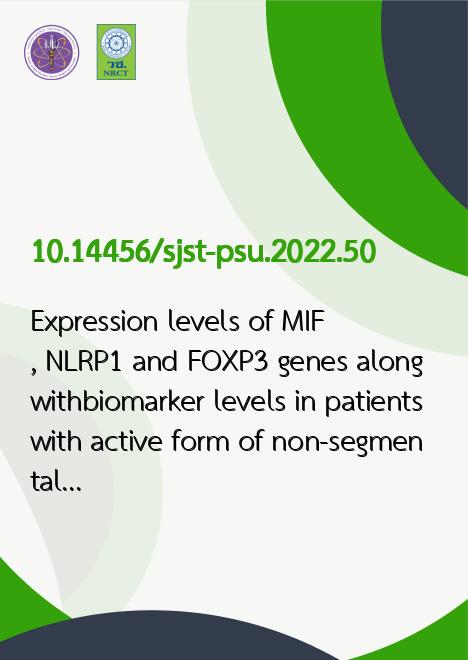
|
Expression levels of MIF, NLRP1 and FOXP3 genes along withbiomarker levels in patients with active form of non-segmentalgeneralized vitiligo: A study in South Indian population |
|---|---|
| รหัสดีโอไอ | |
| Creator | 1. Alokananda Chakraborty 2. Seelamneni Thulasamma 3. Shravan Kumar Ghali 4. Priyanka Pallapolu 5. Kuna Lahar 6. Towseef Amin Rafeeqi 7. Gulam Mohammed Husain 8. Farhath Jabeen 9. Ghazala Javed 10. Mohammed Abdul Waheed 11. Munawwar Husain Kazmi |
| Title | Expression levels of MIF, NLRP1 and FOXP3 genes along withbiomarker levels in patients with active form of non-segmentalgeneralized vitiligo: A study in South Indian population |
| Publisher | Research and Development Office, Prince of Songkla University |
| Publication Year | 2565 |
| Journal Title | Songklanakarin Journal of Science an Technology (SJST) |
| Journal Vol. | 44 |
| Journal No. | 2 |
| Page no. | 353-360 |
| Keyword | vitiligo, MIF, NLRP1, FoxP3, TNF-ฮฑ, MDA, TAS |
| URL Website | https://rdo.psu.ac.th/sjst/index.php |
| ISSN | 0125-3395 |
| Abstract | Vitiligo, the most widespread hypopigmentary syndrome, is considered to be a multifactorial disease in which theactive melanocytes are lost. Vitiligo has been studied in a variety of ways, and several genes have been implicated. In this studywe focused on investigating biomarker levels of TNF-ฮฑ, MDA and TAS by using ELISA, and along with that mRNA expressionlevels of MIF, NLRP1 and FoxP3 genes were quantified with qRT-PCR. In expression studies, Non-segmental GeneralizedVitiligo (NSV) subjects had a substantial (P <.05) fold change in MIF gene expression compared to healthy subjects, with a 0.7change in expression level. In FoxP3 and NLRP1, however, there was just an 0.3-fold change in expression. However, there wasa substantial increase (P <.01) in TNF-ฮฑ and (P <.0005) in TAS levels, but no difference in Malondialdehyde levels (MDA). Thecurrent study is a baseline study suggesting that MIF, with a 0.7-fold change, may play a key role in the pathogenesis of activeNSV subjects, while changes in NLRP1 and FoxP3 mRNA expression levels were weaker. We also found a significant increase(P <.01) in TNF-ฮฑ and (P <.0005) in TAS levels, which may be noted as a key feature in Vitiligo subjects. |
